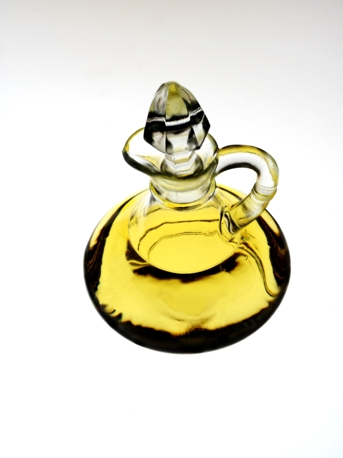Making Infused Oils with Your Students
27 February 2010By Colin Roche, CEC, CCE
 Though easy to make, infusing oils adds much to the classroom and curriculum.
Though easy to make, infusing oils adds much to the classroom and curriculum.
Infused oils are a great product to make with your students. It not only introduces them to the various herbs and spices available today, but also teaches them how to infuse the flavor into the neutral medium of oil.
Why is oil a great medium for infusing flavors into? Herbs and spices get their flavors from the essential oils in them. Most of these oils are aromatic compounds that we smell when we eat them, and it is these aromas that create much of the flavor we experience. Also, because these aromatic compounds are oils, they're soluble in oils. Simple, right? Now, with an understanding of the method, you can see that infused oils are theoretically very easy to make.
Some applications that you can share with and show to your students are the wonderful vinaigrettes and marinades infused oils can make—there is nothing better than drizzling some over grilled vegetables. In addition to being an excellent flavor carrier, infused oils also make a dramatic impact to plate presentations. Just swirl a few droplets of infused oil into a sauce or, better yet, drizzle some on a white plate around an entrée or salad for a great visual effect.
Different seasonings have different levels of intensity, so exact amounts are a matter of experimentation and tasting. But as a general rule, 1/3 cup dried spices or 1 cup packed fresh herbs are used for every 2 cups of oil. Some suggested spices are cardamom, cumin, star anise, cinnamon and cloves, or strong-scented herbs such as rosemary, tarragon, chives, dill, mint or oregano. You can use just one herb, a single spice or a combination of them.
For herb oils, use whole, fresh leaves. For spiced oils, either whole or ground will do. If you choose ground spices, strain the oil through cheesecloth before bottling it. Whole spices and herbs can be left in the oil for decoration. They will keep strengthening the flavor of the oil over time. (NOTE: If using leafy herbs as your flavoring ingredient, you may want to blanch them quickly in boiling water and then shock in cold water first to help preserve their color and give the finished oil a pleasing green appearance.)
So as you can see, making flavored oils is easy, and the end product can add a lot to your classroom and curriculum. After you try making some with your students, they will be amazed at how easy something so delicious and versatile is to make. Infused oils make a great base for salad dressings, marinades and sauces, and you can use them instead of spices and herbs to add flavor to vegetables and meats.
Colin Roche is department chair at the College of Culinary Arts at the North Miami campus of Johnson & Wales University, as well as an assistant professor teaching a variety of culinary and hospitality courses.
Photo credit: © Ed Isaacs | Dreamstime.com, http://www.dreamstime.com/stock-photo-olive-oil-in-cruet-rimagefree1267392-resi1793763
